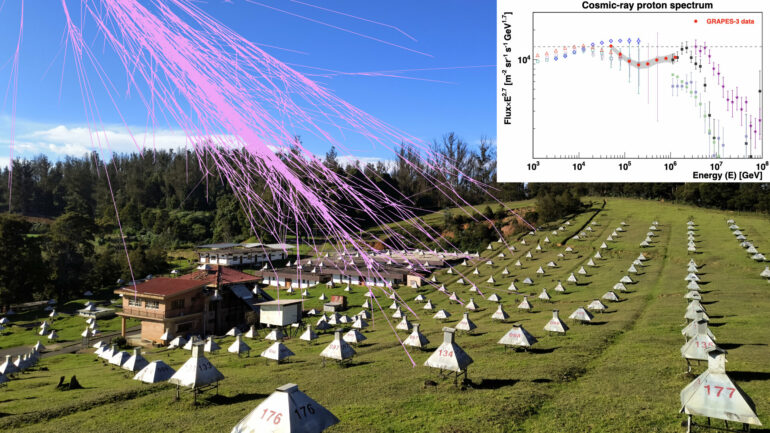The GRAPES-3 experiment in Ooty, India, operated by the Tata Institute of Fundamental Research has discovered a new feature in the cosmic-ray proton spectrum at about 166 tera-electron-volt (TeV) energy while measuring the spectrum spanning from 50 TeV to a little over 1 peta-electron-volt (PeV). The observed feature suggests a potential re-evaluation of our understanding of cosmic-ray sources, acceleration mechanisms, and their propagation within our galaxy.
The study was led by Pravata K. Mohanty, the Principal Investigator of the GRAPES-3 experiment and a faculty member at the Tata Institute of Fundamental Research, Mumbai. The findings have been published in Physical Review Letters
Cosmic rays were discovered more than a century ago. They are considered to be the most energetic particles in the universe. Our planet is constantly bombarded by them from outer space almost uniformly from all directions at a constant rate. They enter into Earth’s atmosphere and induce a shower of particles that travel to the ground almost at the speed of light. The shower particles constitute electrons, photons, muons, protons, neutrons etc.
Cosmic rays have been observed over a remarkably wide energy range (108 to 1020 eV). The flux of cosmic ray particles decreases steeply with energy according to power law.
A kink in the cosmic-ray proton at about 3 PeV known as the “Knee,” which was discovered about seven decades ago, is believed to be the maximum energy for cosmic-ray acceleration within the Galactic sources. Single power law description of the cosmic ray spectrum up to the Knee energy has been proposed for a long time and explained by various models. This observation by the GRAPES-3 experiment shows a new feature above 100 TeV and below the Knee.
Utilizing a combination of a dense array of plastic scintillator detectors and a large-area muon detector, the researchers at the GRAPES-3 experiment collected data with a collection area several thousand times larger than space-based detectors, allowing for a more detailed examination of cosmic rays above 100 TeV, where space-based measurements lack precision due to low statistics.
A subset of about 8 million cosmic ray shower events recorded by these detectors was analyzed by Fahim Varsi and other team members, who used CPU-intensive computer simulations to measure the cosmic-ray spectrum.
More information:
F. Varsi et al, Evidence of a Hardening in the Cosmic Ray Proton Spectrum at around 166 TeV Observed by the GRAPES-3 Experiment, Physical Review Letters (2024). DOI: 10.1103/PhysRevLett.132.051002
Provided by
Tata Institute of Fundamental Research
Citation:
A new kink in proton spectrum to enhance our knowledge of cosmic ray origin (2024, February 2)



